Text
Index
Source Reviews:
Source Review 01
Source Review 02
Source Review 03
Source Review 04
Source Review 05
Source Review 06
Source Review 07
Source Review 08
Source Review 09
Source Review 10
Source Review 11
Source Review 12
Rough Notes
The Big List of References
Aims of Research
Set Up/Planning Post
Initial Ideas
Script and Storyboard
Recce Report
Dream Cast
Version 01
Version 02
Casting
Shooting and Editing Schedules
Production Diary
Mirtazapine: Final Edit
Mirtazapine Bloopers!
Final Evaluation
0 notes
Text
Evaluation
In this evaluation I aim to assess my final product and how my research through my textual analysis led to the realisation of my film and how I linked this to my preferred director, Hayao Miyazaki. My main focus is how I conveyed Miyazaki's staple themes through my own creative vision. This is shown clearly through the aspects of mise-en-scene, cinematography and the editing of my five-minute short. I specifically focused on the idea of how Miyazaki portrays women (and their subsequent growth/battle with adulthood and mental health) as well as his obsessive nature as a director. In relation to my research I feel I was able to communicate the messages and themes of the films directed by Miyazaki and Yonebayashi and how they've influenced me as a film student.
In my textual analysis I learnt that consistently throughout Miyazaki's films he implements a few specific key themes: a female protagonist, themes of flight/escape and the beauty of nature. Almost like visual representation of the jarring differences between western animation and east, Miyazaki's almost wistful shots of broad and beautiful landscapes are but a small glimpse into the man's undying love for nature and all her quirks. With my limited schedule and budget, I decided the best way to demonstrate my understanding of Miyazaki's love I combined the theme of flight with nature coming to the conclusion of using birds as a motif that symbolises both ideas. This was both a realistic decision and a creative one as it allowed me to express my own interpretation of these ideas as well as being able to find and capture footage of birds (who are of course, everywhere). The beginning of my film was also greatly inspired by Miyazaki's use of the 'longing' establishing shots, where he focuses on the mundane but manages to make it the most interesting and wonderful thing by simply hanging on a tap dripping for a little bit longer than most would. The second scene of my film sets up several establishing shots of the house not just to set up the scenes ahead but to offer up a parallel of his work to mine as well as to show an understanding of his work and how it's influenced my own.
I freely admit that due to my inability to animate and limited time my artefact will never truly meet it's goal however I tried my utmost best to emulate/capture the essence of his films despite being a live action film. For example I included an implication of the supernatural in the key scene at the very end of my film in which my character, Perry, 'becomes' a bird – whether she does actually or not is up to the viewer and how much they literally interpret the implication. The supernatural element can be found throughout all three of the films I studied for my textual analysis, Chihiro and the literal spirit world, Princess Mononoke and the forest spirits and Anne and her grandmother's spirit Marnie in When Marnie was There. Instead, the live action aspect of my film lent well to the realism and grounded nature I was aiming for as I attempted to portray mental health and growing up as realistically as possible. For example, the residential aesthetic of my film had to replace the natural countryside/spirit realm aspect in Miyazaki's films for not just budget reasons but to also ground the film and possibly help people relate to my main character. In the scene in which Perry's dog comforts her once she's come home from having a meltdown at college was deliberately shot in the bathroom as a bathroom is a fairly private place in which you're sometimes openly bare and raw so I feel like people will relate to Perry's raw openness in a more common location rather than a bathhouse. Another reason (which I will further explain later) is that many people have a disregard for younger adolescents and adults and mental health so by seeing Perry in such a sacred and private place crying may perhaps open their own eyes to see just how much she is suffering. I also changed the gradient of the first part of the film to a much darker and murkier quality to represent Perry's own way of viewing her surroundings instead of the much brighter and colourful palettes that Miyazaki is prone to. The greyish palette and use of natural light helps heighten the sense of misery and despair that Perry feels in her sadness which I feel Miyazaki does not always achieve in portraying.
The latter half of the film is much more like a Miyazaki film in that the use of starker and brighter colours and higher gradient are much more fantastical than the grey used for the realistic aspect. The change to more popping colours for the latter half of the film was to demonstrate the drastic difference Perry feels once she dons the costume and 'becomes' her true self. Just like how Anne starts to wear blue as an homage to Marnie (as that was her primary colour) Perry sees the world in a much more heightened, exciting way to previous scenes – shown through the use of colour. Even the music changes from the sombre 1920s-esque cover of 'After You've Gone' by Jessy Carolina to the upbeat 'Pill Popper' by Christian Hansen in order to demonstrate how the delusion Perry has created has changed the way she now views the world – she has become happy, invincible and the quick, rapid fire editing of the scene where Perry is running through the neighbourhood is done to show just how much she's changed.
One scene in particular that I want to talk about is the scene where Perry 'discovers' the bird costume hanging off her shelf and when she walks up to it her shadow appears. This scene in particular is almost like the beginning and the end of Perry. In a way it's the end of Perry as we knew her at the beginning and is the start of her delusion – the shadow is the physical manifestation of this, there to point out that almost two Perrys' are born in that moment, the one that dies (her old self) and the one that is born (her new, deluded self). This scene is a homage to the beautiful moment where Chihiro, now Sen, has left the bathhouse in order to find Zeniba to return the stolen seal. In this scene, Chihiro, Yubaba's baby and her spy crow as well as No-Face all enter the train, leaving behind Chihiro's innocence and No-Face's ravenous hunger for validation and leave as stronger, more independent adults. I wanted to capture that moment, where the two main characters meet themselves and leave with their new version. But most importantly however, both scenes deal with the idea that change comes from within but also from outside. Chihiro changes into a better version of herself thanks to the loving patience of Lin, Kamiji and Zeniba as well as her love for Haku, and Perry changes due to the isolation she feels and pressure to conform – and that 'transforming' into a bird is Chihiro's train journey, it's Perry journey into the new her – even if it's for the worse. As I aforementioned, society is still uneasy when it comes to mental health and it's rampancy in adolescence. If anything most will treat people with mental health issues with an air of distrust, not wholly believing that some conditions are 'real' or that people fake it for attention. Even the song used in my film, 'Pill Popper' mocks depressed women who are drug addicts and steal for attention.
All in all, whilst there are many issues within my film and not being able to animate was a huge letdown, I feel like my artefact was more or less successful in becoming a blend of Miyazaki's themes and messages.
0 notes
Text
Mirtazapine - Final Draft
The final draft of my film, Mirtazapine, at 05:10 long.
youtube
0 notes
Text
Production Diary
15.03.18 - We shot the second scene of the film over a lunchtime of about an hour. The lighting wasn’t an issue as the room was well lit despite the shoddy weather outside. The shooting went off without a hitch and the teacher was kind enough to give us enough time before she had to come in to teach. The tripod has seen some damage to it’s forward leg (due to it being pressed to hard in my packed bag, wasn’t a great idea to put it in there I know) but it isn’t anything too serious and it can still be used.
26.03.18 - Me and my cameraman met to shoot the third and forth scenes. Production went fine and the lights were stable so luckily nothing broke or fell over.
02.04.18 - Me and my cameraman went to shoot in the avenues were I lived (much to many peoples amusement) were it went off without a hitch.
06.04.18 - Edited a first draft for my film, which took about two hours and the draft lasts for around five minutes and ten seconds.


(making of costume)
0 notes
Text
Shooting and Editing Schedules
I have checked in advance the weather forecast of the day to ensure that I have good lighting for my scenes. However, as most shooting will take place indoor weather will probably not affect the filming in any way, other than the lighting coming through the windows.
15.03.18 - Primary shooting.
26.03.18 - Primary shooting, with some secondary.
06.04.18 - Secondary shooting.
07.04.18 - The day after will be spent checking over scenes in case we need to reshoot.
08.04.18 - This day will be reserved in case of additional shooting.
0 notes
Text
Dream Cast (English Ver.)

(from left: Sally Hawkins, Cate Blanchett, Gillian Anderson and Rooney Mara)
For Va.1 I would cast Cate Blanchett because not only has she an incredible track record of excellent performances Blanchett is no stranger to voice work, making her an ideal actress to play a character in my film. She has proven herself to be capable of playing a solemn, downcast character before (Jeanette Francis in Blue Jasmine and Carol Aird in Carol) which suits the nature of Va.1 perfectly as well as having an already established connection to Rooney Mara (Therese Belivet in Carol) and Sally Hawkins (Ginger in Blue Jasmine). For Va.2 I would cast Rooney Mara for her incredible accent potential as well as her ability to play rough characters as shown in Tanner Hall (Fernanda) and in ‘The Girl with the Dragon Tattoo’ (Lisbeth Salander). I would cast Gillian Anderson as Va.3 because she has already been in a fair few Studio Ghibli films (Moro in Princess Mononoke and Dr. Miki Hokuto in From Up on Poppy Hill) which gives her a familiarity with what would be expected of her as well as her incredible legacy as an actress which has seen her play roles similar to Va.3, most notably Dana Scully from the X-Files.
And of course, who could forget the lovely Sally Hawkins as Perry. Not only is her character Elisa Esposito from ‘The Shape of Water’ almost near identical in some aspects, she is also an incredible actress who can make you cry without saying anything as well as having the on-screen presence of a goddess.
0 notes
Text
Dream Cast (Japanese Ver.)
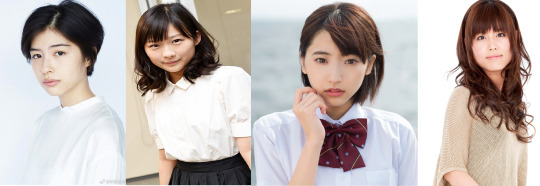
(from left: Yui Sakuma, Sairi Ito, Rena Takeda and Miyuki Sawashiro)
After seeing both Sakuma and Ito in Transit Girls (2015) I immediately fell in love with their versatile acting skills as well as their emotional performance throughout the show. Whilst Sakuma has very little acting experience she is already well on her way to a promising career and I feel justified in casting her as her acting resonated with me as well as her very conflicting nature which reflects Perry’s quite nicely. Ito played such a excellent counterpart to Sakuma that is only makes sense to cast her as Va.1, Perry’s best friend. Ito’s vocal range in terms of emotion is also quite impressive and would be excellent for a va. only role. She also often plays characters of a young age which would fit with the young age of my characters and she has in the past played a similar role to Va.1 in ‘The Queen’s Classroom’. Then there is Takeda who is no stranger to live-action adaptations of anime. She would fit perfectly as Va.2 because of her ability to play aggressive, loud-mouth or determined characters such as Mizuki Mizusawa from Kamen Rider: Amazon.
Finally there is the goddess herself, Miyuki Sawashiro. Sawashiro is one of the most celebrated female voice actresses from Japan and is well known for her sultry, smooth voice that can express an impressive range of tones and pitches. I for one, if you couldn’t already tell, am a huge fan of her work with her voice acting some of my favourite characters in an anime with her work spanning over a decade since 1999. Sawashiro’s voice would just work so brilliantly as Va.3 as they are very similar to characters she’s already played such as Hagino Senkōji from Blue Drop: Tenshi-tachi no Gikyoku as well as Canaan from the anime of the same name.
LINKS TO CREATIVE INVESTIGATION:
There are two casts because a Ghibli film is made with Japanese va. and then later translated into English with an English va.
0 notes
Text
OG Casting
When casting the role of Perry in my film, I needed a young, female actor with a ‘normal’ appearance who could exhibit a wide arrange of emotions - this is because of the journey my character will undergo. Unfortunately, the hunt for a decent actress didn’t go very well as many people stated they had stage fright, so I had to cast myself. However, casting for the voice over was much easier. My cameraman, Grace, was willing to voice one of the characters and was very useful in terms of expressing sadness for the character as she related to her.

Casting myself might seem like a pretentious move but in reality there was literally no one who wanted to be in my film (too camera shy etc) so it was up to me to take on the role of everyone but cameraman
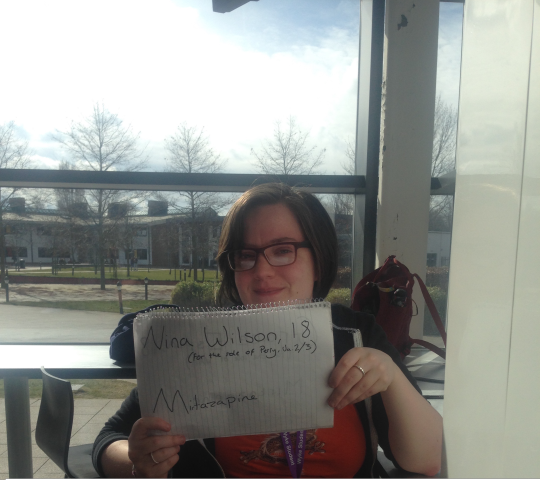
Auditions: https://www.youtube.com/watch?v=6SPkKj_8xXQ
0 notes
Text
Storyboard
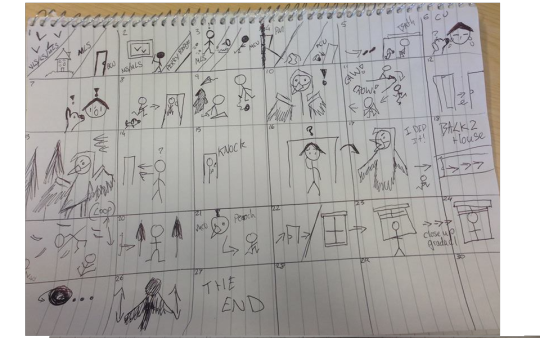
LINKS TO CREATIVE INVESTIGATION:
Unfortunately I didn’t have anywhere the amount of time (or patience) that Miyazaki has but I aimed to have the exact type of shot and length planned with little notes of what I wanted to be said or other such indicators.

0 notes
Text
Recce Report
Bedroom: My bedroom is a suitable location for my film as it has a huge window for natural light but also it is spacious so it has room to move around thus allowing some scenes to have energy in them. Because my room is obviously lived in, it will create a vibe that will make it look like my character has lived there too.
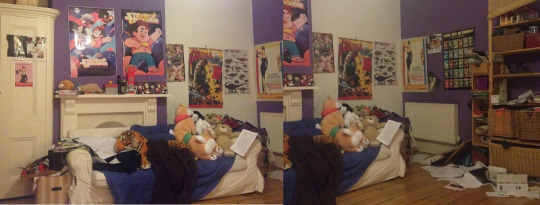
Garden: My garden features some great light but also because there are a lot of trees it will cover the garden and thus my character, creating a eerie dark vibe which will also reflect the colour change throughout my film. The garden will also act as a link between Miyazaki's love of nature and my film.

Bathroom: My bathroom is a small, compact room that will be really useful for the up-close shot of my character crying which also has some great lighting from the two windows.

Avenues: The avenues (where I live) is a great bundle of spacious streets that are packed with varying nature that will again act like a link between the two films. Because they are often empty, it will allow me and my cameraman to film without much hassle.
Hallways: Because my hallway is long and has the benefit of (during the day) being a good source of open space with good lighting. Because of the length and space I will be able to move around more freely.
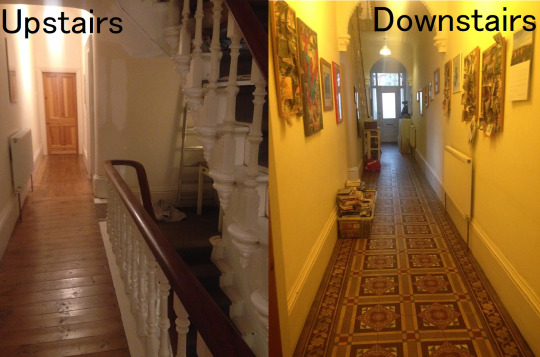
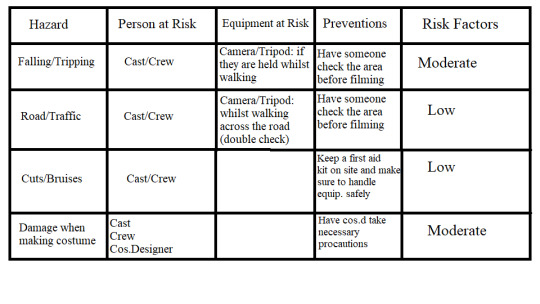
LINKS TO CREATIVE INVESTIGATION:
I chose my locations because they were the closest to the locations seen in When Marnie was There, one of my focal films (also it’s not like i could fly to japan for my locations). The Marsh House featured in the film is not that dissimilar to my own as well as having the avenues and park act as the nature-themed backdrops as seen in Miyazaki’s films.
0 notes
Text
Script
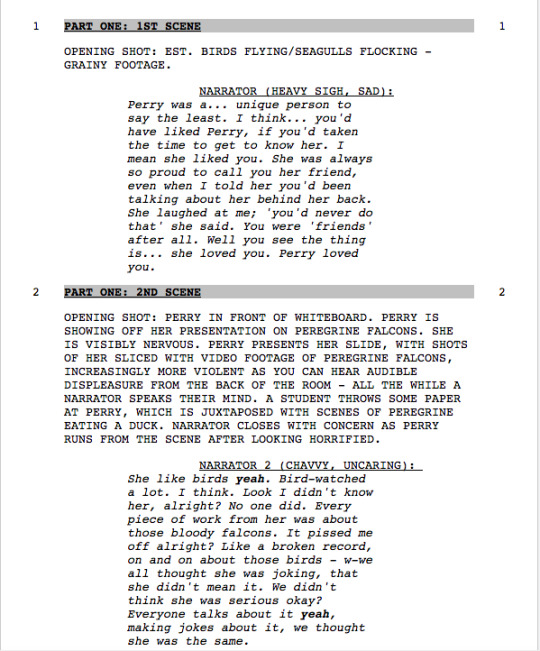
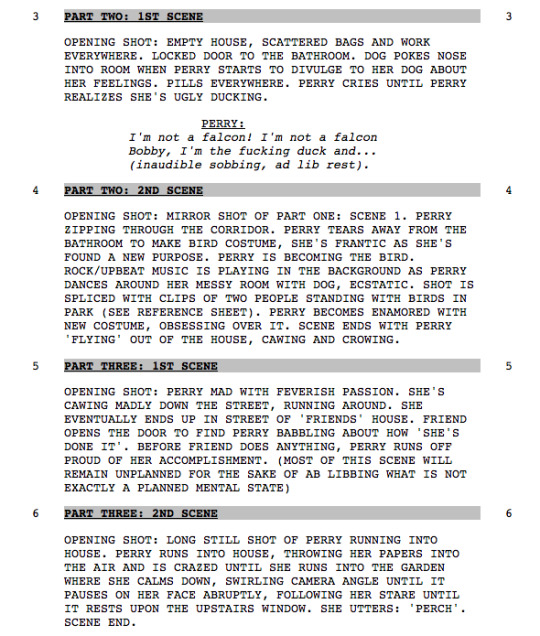
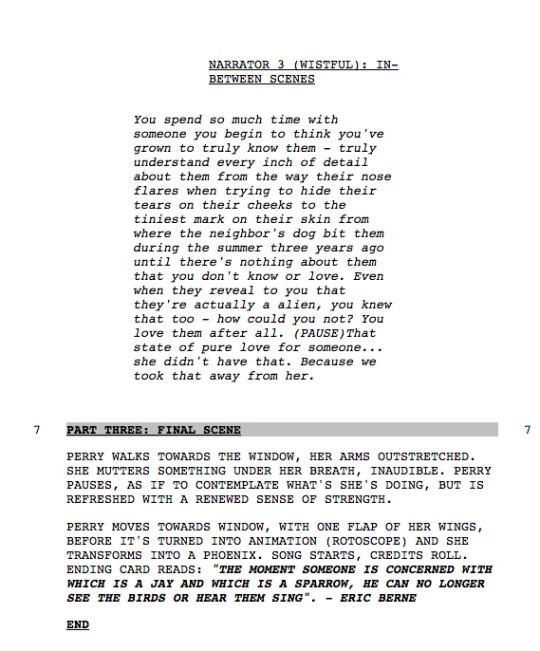
LINKS TO CREATIVE INVESTIGATION:
I chose this narrative because it closely follows the formula found in my creative investigation - a girl goes through an ordeal and finds her meaning in it. I wanted to do the same but make it mine, show my side of things. Whilst I love Miyazaki’s adoration of a happy ending I believe that there are different kinds of ‘happiness’ and thus I wanted to show it in my version of a Ghibli film.
0 notes
Text
Initial Ideas
· 3-5 minutes in length,
· Fit Miyazaki’s signature style
· Micro-technical features that I should use in the film
· Based off of three focal films that I have studied.
· The macro-concept of representation.
INSPIRATION:
My film will use the idea of colour to highlight emotions such as Miyazaki and Yonebayashi, like how Yonebayashi uses colour to illustrate the different ‘classes’ between the two girls but also their cultural differences (Marnie is European, so she has blonde and blue eyes etc.) I will also try to use establishing shots and long shots, as does Miyazaki, as well as include lots of footage of nature to try and replicate the usual shot or two he has of the environment. Upon finishing my essay I realised that Miyazaki almost always has a female protagonist and includes some form of nature (whether that’s a spirit of nature or a literal representation of mother nature herself in the form of bugs).
GENRE:
The genre of my short film will be a drama laced with a dreamlike haze, subverting what Miyazaki usually does but including enough elements that those who have seen a Miyazaki film will recognise, throwing back to the Ghibli of old such as Grave of the Fireflies (1988) Princess Mononoke (1997) and Nausicaä of the Valley of the Wind (1984) – the more dramatic and violent Studio Ghibli films. The aforementioned films as well as my three focal films are all dramas as Miyazaki often uses a conflict of any nature as a springboard for his characters to bounce off of and grow. I too will have a conflict that sparks my character’s revelation as I aim to fit with Miyazaki’s tropes and themes. Whilst my film will not be an animation, I will aim to replicate some of the stylistic choices that come with the Miyazaki art style by using bright colours in both location and costume.
MESSAGES AND VALUES:
Like with any of Miyazaki’s films the messages and values I will communicate are key to the meaning of the story. The underlying message is not only personal but what I believe to be extremely important, just like Miyazaki believes in his characters and what they represent in his narrative as well as message of the film. This is why I plan on creating a film that encompasses all that I am and executing that through a voice similar to Miyazaki’s.
FILM SYNOPSIS:
As my film is inspired by Hayao Miyazaki, my film will predominately feature his most common themes: female protagonist, nature and themes of flight/escape. After some heavy internal debate, I figured I would take his themes and realise them in a literal sense so my film with feature a female protagonist who believes she’s a bird (nature + flight) and she ‘escapes’ through ‘accidentally' killing herself by throwing herself out of a window.
The protagonist will be a young adolescent, living alone with her dog, who we see has an unhealthy passion for birds (as well as medication, implying there might be something else behind the scenes). After attempting to present her powerpoint to the class about falcons she is booed off and goes home, crying her eyes out. She then has a revelation after talking to her dog (who is the reflection of Mono in Mononoke/Marnie in WMWT/Haku in Spirited Away) and creates a bird costume. After parading round the park, streets and friend’s house she eventually attempts to take flight by jumping out of a window, ending the film.
LOGLINE:
Perry Grinne-Smith is a college student who is mocked and berated for her passion for birds until she’s driven mad and begins to slowly believe she is a bird.
LINKS TO CREATIVE INVESTIGATION:
I chose this narrative because whilst it is probably nothing like a Miyazaki film in execution, it’s like an amalgamation of all his themes, of me growing up with his films and how I am now. The plot vaguely follows a typical Ghibli films, a girl goes through some turmoil and finds her resolution through it - mines just a bit darker than normal.
0 notes
Text
Set-up
Set:
1 scene at college
My house, predominantly the bathroom, my room and brother’s room
My street
Friend’s house (possibly for a small shot)
Props:
Heaps of paper = ‘research’
Bird books
Pills, knife
Costume:
Bird Costume (paper hat, hoodie and old bedsheet)
Music:
Blue Reflection OST
I am Setsuna OST
Ending Song: Lacy Loo by The Regrettes
0 notes
Text
Aim of Research
The aims of my research are centered around the study of Hayao Miyazaki and if he has become a brand name or if he truly is the auteur of his films. Miyazaki has caused quite a stir within the film industry, with people debating whether he is the first animation auteur or if there is such a thing in the first place.

When Marnie was There:
Cinematography: MLS, BCU, MS and MCU
Editing: dream sequence, shot reverse shot, establishing shot,
Sound: Diegetic OST, Voiceover (Thoughts),
Mise-en-scene: Sea/Water(Blue) = Marnies’ dress, Annas’ eyes/clothes
Spirited Away:
Cinematography: VLS, LS, MLS, MCU, CU, BCU
Sound: Diegetic OST,
Editing: shot reverse shot, establishing shot, dream sequence
Mise-en-scene: Spirits = Nature
Princess Mononoke:
Cinematography: XLS, VLS, LS, MLS, MCU, CU, BCU
Sound: Monologue, Diegetic OST
Editing: long take, shot reverse shot, establishing shot
Mise-en-scene: Black goop/demon blood/possession = industrial pollution
0 notes
Text
The Big List of References:
1.) Christina (2014): Studio Ghibli and the Female Protagonist. Available Online: https://prologuetoablog.com/2014/10/05/studio-ghibli-and-the-female-protagonist/comment-page-1/
2.) Baritaux, Zio (27/02/2017): girlhood and girl power in studio ghibli films. Available Online: https://i-d.vice.com/en_us/article/wjdqzm/girlhood-and-girl-power-in-studio-ghibli-films
3.) Michael, Chris (06/06/16): 'Women are realistic, men idealistic': Studio Ghibli on why a director's gender matters. Available Online: https://www.theguardian.com/film/2016/jun/06/studio-ghibli-yonebayashi-interview-miyazaki
4.) Rose, Steve (14/07/11): Studio Ghibli: Leave the Boys Behind. Available Online: https://www.theguardian.com/film/2011/jul/14/studio-ghibli-arrietty-heroines
5.) Sillett, Pete (28/02/15): Hayao Miyazaki: Authorship and Aesthetic Influence.
Available Online: http://nolightingnecessary.blogspot.co.uk/2015/02/hayao-miyazaki-authorship-and-aesthetic.html
6.) Bramesco, Charles (01/02/17): The Future of Studio Ghibli in a Post-Miyazaki World. Available Online: https://www.theverge.com/2017/2/1/14474010/hayao-miyazaki-studio-ghibli-red-turtle-ronja-robbers-daughter
7.) Swale, Alistair (07/07/15): Miyazaki Hayao and the Aesthetics of Imagination: Nostalgia and Memory in Spirited Away. Available Online: http://www.tandfonline.com/doi/abs/10.1080/10357823.2015.1056086?journalCode=casr20
8.) Spelman, Jack (25/05/10): Conclusion. Available Online: http://jackspelman.blogspot.co.uk/2010/05/
9.) Kevin M. Moist and Michael Bartholow (01/03/07): When Pigs Fly: Anime, Auteurism, and Miyazaki’s Porco Rosso. Available Online: http://journals.sagepub.com/doi/abs/10.1177/1746847706068904
10.) Videocaddy (22/09/14): World’s Only Animation Auteur Hayao Miyazaki Does His Own Storyboarding. Available Online: https://www.videocaddy.com/blog/worlds-only-animation-auteur-hayao-miyazaki-does-his-own-storyboarding/
11.) Roberts, Jon (29/07/17): Auteur: Hayao Miyazaki. Available Online: http://www.sothetheorygoes.com/hayao-miyazaki/
12.) Yee Ang, Bin (2013): Aesthetics and Auteurism of Miyazaki. Available Online: https://www.academia.edu/24505389/Hayao_Miyazaki_as_Auteur_Techniques_Technology_and_Aesthetics_in_Animation?
13.) Adnan, Bey (10/08/2015): Hayao Miyazaki: The Art of Repetition. Available Online: https://the-artifice.com/hayao-miyazaki-art-repetition-studio-ghibli/
14.) Abby (2008): Hayao Miyazaki: The Anime Auteur. Available Online: http://tx.english-ch.com/teacher/abby/level-c/hayao-miyazaki-the-anim-auteur/
15.) Rafal (2010): Animated Auteur? Available Online: http://rafal.qwriting.qc.cuny.edu/2010/12/17/animated-auteur/
16.) Tan, Fidelis (2011): Hayao Miyazaki: Anime Auteur. Available Online: https://inthegrayworld.wordpress.com/2011/03/16/hayao-miyazaki-anime-auteur/
17.) Sarena (04/04/11): Animating Auteurism: Contemporary Japanese Animator Hayao Miyazaki According to 1950’s Auteur Policy. Available Online: http://writereadcreate.blogspot.co.uk/2011/04/animating-auteurism-contemporary.html
0 notes
Photo





Rough Film Notes for Spirited Away and When Marnie was There (date: 19th September)
0 notes